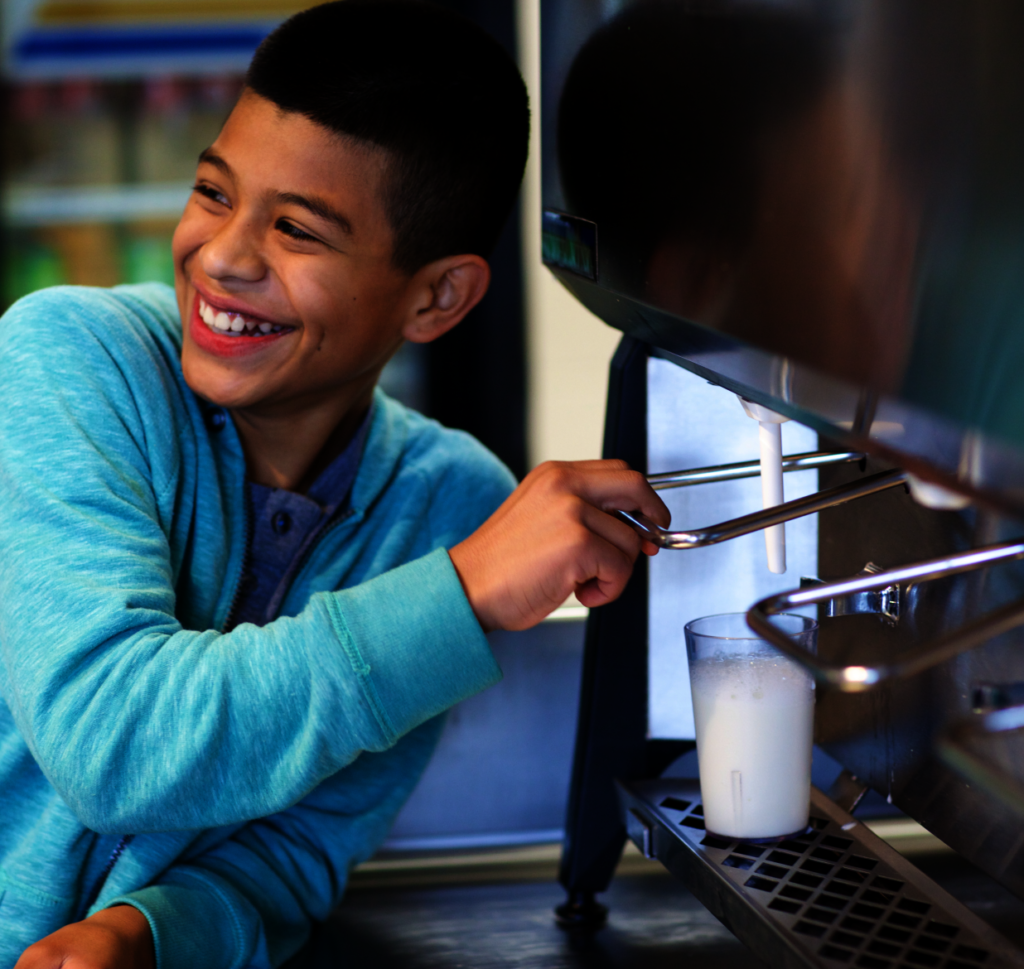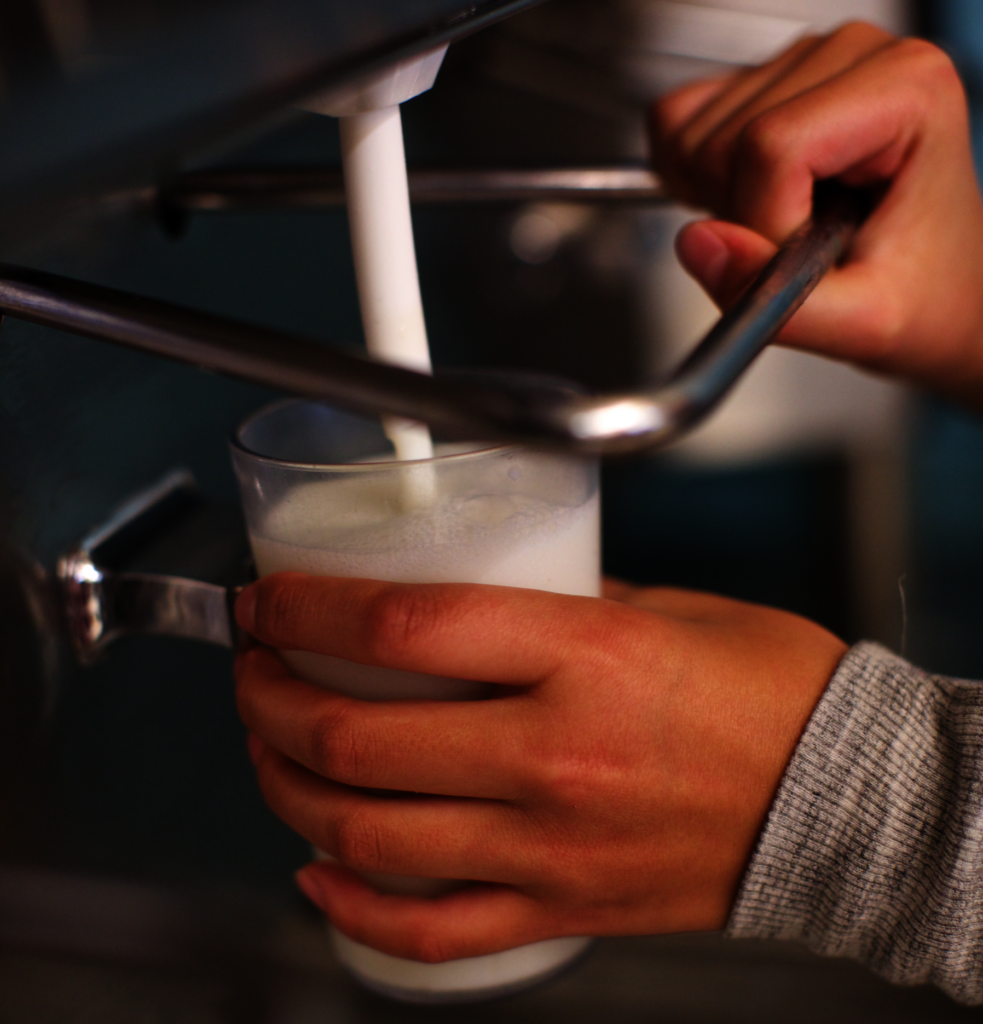By Chef Ann Foundation | Staff Contributor
Milk has been a long-time staple in school food. Think back to when you ate school lunch, and you’ll probably remember a small carton of milk sitting on your lunch tray. Today, the USDA guidelines for the National School Lunch and Breakfast Programs require that either low- or non-fat milk be offered with every school lunch or breakfast.
As a result, most schools serve children their milk in either an eight-ounce carton or plastic bottle as they make their way through the lunch line. With more than 31 million kids eating school lunch and more than 13 million eating school breakfast every single day — year after year — those cartons and bottles are really adding up.
We’re excited to announce our newest program, Bulk Milk, a project to help school districts transition from conventional milk served in individual bottles/cartons to bulk milk dispensers with reusable plastic tumblers. By switching to bulk milk, schools will eliminate tons of plastic bottles and cartons from the waste stream and cut down costs related to wasted milk. Additionally, schools can make financial shifts that will enable them to switch from conventionally-produced milk to organic.
The Problem with Bottles and Cartons
At first glance, carton or bottled milk seems convenient. Children get their eight ounces in neat, easily distributed packages. But cartons come with many consequences, a major consequence being waste. According to a recent World Wildlife Foundation report, school food programs provide an estimated 275 million half-pint carton servings of milk to students each day throughout the school year, resulting in packaging waste and milk waste if the carton is left unfinished. It’s estimated that 45 million gallons of milk is wasted each school year, which comes out to roughly 32 cartons per student every year. This not only represents a loss of nutrition, but also the environmental and financial resources that go into producing, transporting, cooling, and storing milk. Milk waste from bulk milk dispensers (BMDs) is much lower at roughly 4.5 cartons per student— saving 248 gallons of water and 30 pounds of CO2e per student annually. To put those savings in context, that’s equivalent to almost 1.5 times the amount of water the average person consumes on a yearly basis and 33.8 miles driven by a gas-powered vehicle. While this impact may appear small at first, with 49.5 million students attending K-12 schools in the US, this would be the same as taking over 145,000 gas-powered vehicles off the road each year. BMDs offer schools a practical pathway to lower their annual costs while also achieving environmental reductions in waste, greenhouse gas emissions, and energy use. Students prefer the flexibility to serve themselves only what they need, which helps to reduce waste and increase overall consumption of a key and nutritious staple of the NSLP.
The Bulk Milk Solution
Bulk milk greatly reduces the amount of waste produced by lunchrooms across the country, and also encourages kids to consume more milk since the dispensers have better temperature retention than the individually packaged cartons, meaning the milk remains icy cold and more appealing.
“Dispenser milk is always cold and delicious, so kids drink more,” says Chef Ann Cooper, founder of Chef Ann Foundation and former director of food services at Boulder Valley School District in Colorado. Having implemented milk dispensers in her lunchrooms years ago, Chef Ann reports that “the self-serve component helps alleviate waste,” making bulk milk a “win-win” for school districts.
School food staff at the Canby School District in Oregon reported that students tend to take what they drink and drink what they take from bulk milk dispensers, which means that less milk is being thrown out, reducing both waste and costs. Since implementing bulk milk dispensers, the district has noted a 40% reduction in milk purchasing costs and a 40% increase in milk sales which means that more students are purchasing milk and wasting less of what they take.
More Benefits of Bulk Milk
“Since switching to bulk milk, we’ve noticed increases in consumption and decreases in waste. The kids love the taste and enjoy drinking from a cup instead of a carton. Our average milk waste was about ½ cup per child with cartons, and with bulk milk, that has decreased to less than 1/8 cup per child. We are also seeing a savings from purchasing bulk milk instead of cartons – $285 per week at our pilot school. Additionally, there have been no issues with the reusable cups. Students return the cups to a kitchen window after discarding their trays, and staff washes the cups for their next use.” -– Rita Denton, Director of Student Nutrition Mansfield ISD, Mansfield, Texas
Advocating for Bulk Milk
Bulk milk can now be found in many schools across the US, and it is a common feature in many institutional service environments like colleges and hospitals. The production of bulk milk units is common in the dairy industry, and is an option that is both cost effective and environmentally friendly.
Links:
Project reports on GlobalGiving are posted directly to globalgiving.org by Project Leaders as they are completed, generally every 3-4 months. To protect the integrity of these documents, GlobalGiving does not alter them; therefore you may find some language or formatting issues.
If you donate to this project or have donated to this project, you can recieve an email when this project posts a report. You can also subscribe for reports without donating.
Support this important cause by creating a personalized fundraising page.
Start a Fundraiser
